Selective Hydrogenation of Benzene to Cyclohexene over Monometallic Ru Catalysts: Investigation of ZnO and ZnSO4 as Reaction Additives as Well as Particle Size Effect
Abstract
:1. Introduction
2. Results
2.1. Effects of ZnO and ZnSO4
2.2. Effects of Particle Size of Ru Catalysts
2.3. Reusability of Ru-4.7 Catalyst
3. Materials and Methods
3.1. Chemicals
3.2. Preparation of Catalysts
3.3. Catalytic Experimental Procedure
3.4. Catalysts Characterization
4. Conclusions
Author Contributions
Acknowledgments
Conflicts of Interest
References
- Yan, X.H.; Zhang, Q.; Zhu, M.Q.; Wang, Z.B. Selective hydrogenation of benzene to cyclohexene over Ru-Zn/ZrO2 catalysts prepared by a two step impreganation method. J. Mol. Catal. A Chem. 2016, 413, 85–93. [Google Scholar] [CrossRef]
- Zhou, G.B.; Pei, Y.; Jiang, Z.; Fan, K.N.; Qiao, M.H.; Sun, B.; Zong, B.N. Doping effects of B in ZrO2 on structural and catalytic properties of Ru/B-ZrO2 catalysts for benzene partial hydrogenation. J. Catal. 2014, 311, 393–403. [Google Scholar] [CrossRef]
- Sun, H.J.; Chen, Z.H.; Li, C.G.; Chen, L.X.; Li, Y.; Peng, Z.K.; Liu, Z.Y.; Liu, S.C. Selective hydrogenation of benzene to cyclohexene over monometallic Ru catalysts: Investigation of ZnO and ZnSO4 as reaction additives as well as particle size effect. Catalysts 2018, 8, 104. [Google Scholar] [CrossRef]
- Spod, H.; Lucas, M.; Claus, P. Performance of Ru/La2O3–ZnO Catalyst for the Selective Hydrogenation of Benzene to Cyclohexene. Catalysts 2015, 5, 1756–1769. [Google Scholar] [CrossRef]
- Sun, H.J.; Chen, J.J.; Huang, Z.X.; Liu, Z.Y.; Liu, S.C. Selective hydrogenation of benzene to cyclohexene over the nano-sized Ru-Zn catalyst modified by Rrabic gum. Chin. J. Inorg. Chem. 2016, 32, 202–210. [Google Scholar]
- Liao, H.G.; Ouyang, D.H.; Zhang, J.; Xiao, Y.J.; Liu, P.L.; Hao, F.; You, K.Y.; Luo, H.A. Benzene hydrogenation over oxide-modified MCM-41 supported ruthenium-lanthanum catalyst: The influence of zirconia crystal form and surface hydrophilicity. Chem. Eng. J. 2014, 243, 207–216. [Google Scholar] [CrossRef]
- Martins, L.M.D.; Carabineiro, S.A.C.; Wang, J.; Rocha, B.G.M.; Maldonado-Hódar, F.J.; Pombeiro, A.J.L.D.O. Supported Gold Nanoparticles as Reusable Catalysts for Oxidation Reactions of Industrial Significance. ChemCatChem 2017, 9, 1211–1221. [Google Scholar] [CrossRef]
- Martins, L.M.; de Almeida, M.P.; Carabineiro, S.A.; Figueiredo, J.L.; Pombeiro, A.J. Heterogenisation of a C-Scorpionate FeII Complex on Carbon Materials for Cyclohexane Oxidation with Hydrogen Peroxide. ChemCatChem 2013, 5, 3847–3856. [Google Scholar] [CrossRef]
- De Almeida, M.P.; Martins, L.M.D.R.S.; Carabineiro, S.A.C.; Lauterbach, T.; Rominger, F.; Hashmi, A.S.K.; Pombeiro, A.J.L.; Figueiredo, J.L. Homogeneous and heterogenised new gold C-scorpionate complexes as catalysts for cyclohexane oxidation. Catal. Sci. Technol. 2013, 3, 3056–3069. [Google Scholar] [CrossRef]
- Carabineiro, S.A.C.; Martins, L.M.D.R.S.; Avalos-Borja, M.; Buijnsters, J.G.; Pombeiro, A.J.L.; Figueiredo, J.L. Gold nanoparticles supported on carbon materials for cyclohexane oxidation with hydrogen peroxide. Appl. Catal. A Gen. 2013, 467, 279–290. [Google Scholar] [CrossRef]
- Sun, H.J.; Li, S.H.; Zhang, Y.X.; Jiang, H.B.; Qu, L.L.; Liu, Z.Y. Selective hydrogenation of benzene to cyclohexene in continuous reaction device with two reaction reactors in serie over Ru-Co-B/ZrO2 catalysts. Chin. J. Catal. 2013, 34, 1482–1488. [Google Scholar] [CrossRef]
- Sun, H.J.; Jiang, H.B.; Li, S.H.; Wang, H.X.; Pan, Y.J.; Dong, Y.Y.; Liu, S.C.; Liu, Z.Y. Selective hydrogenation of benzene to cyclohexene over nanocomposite Ru-Mn/ZrO2 catalyst. Chin. J. Catal. 2013, 34, 684–694. [Google Scholar] [CrossRef]
- Wang, Z.B.; Zhang, Q.; Lu, X.F.; Chen, S.J.; Liu, C.J. Ru-Zn catalysts for selective hydrogenation of benzene using coprecipitation in low alkalinity. Chin. J. Catal. 2015, 36, 400–407. [Google Scholar] [CrossRef]
- Sun, H.J.; Li, Y.Y.; Li, S.H.; Zhang, Y.X.; Liu, S.C.; Liu, Z.Y.; Ren, B.Z. ZnSO4 and La2O3 as Co-Modifier of the Monoclinic Ru Catalyst for Selective Hydrogenation of Benzene to Cyclohexene. Acta. Phys. Chim. Sin. 2014, 30, 1332–1340. [Google Scholar]
- Canpbell, P.S.; Santini, C.C.; Bayard, F.; Chauvin, Y.; Collière, V.; Podgoršek, A.; Gomes, M.F.C.; Sá, J. Olefin hydrogenation by ruthenium nanoparticles in ionic liquid media: Does size matter? J. Catal. 2010, 275, 99–107. [Google Scholar] [CrossRef]
- Lee, K.; Kim, M.; Kim, H. Catalytic nanoparticles being facet-controlled. J. Mater. Chem. 2010, 20, 3791–3798. [Google Scholar] [CrossRef]
- Pushkarev, V.V.; An, K.; Alayoglu, S.; Beaumont, S.K.; Somorjai, G.A. Hydrogenation of benzene and toluene over size controlled Pt/SBA-15 catalysts: Elucidation of the Pt particle size effect on reaction kinetics. J. Catal. 2012, 292, 64–72. [Google Scholar] [CrossRef] [Green Version]
- Nagahara, H.; Ono, M.; Konishi, M.; Fukuoka, Y. Partial hydrogenation of benzene to cyclohexene. Appl. Surf. Sci. 1997, 121, 448–451. [Google Scholar] [CrossRef]
- Milone, C.; Neri, G.; Donato, A.; Musolino, M.G.; Mercadante, L. Selective Hydrogenation of Benzene to Cyclohexene on Ru/γ-Al2O3. J. Catal. 1996, 159, 253–258. [Google Scholar] [CrossRef]
- Bu, J.; Liu, J.L.; Chen, X.Y.; Zhuang, J.H.; Yan, S.R.; Qiao, M.H.; He, H.Y.; Fan, K.N. Ru/SBA-15 catalysts for partial hydrogenation of benzene to cyclohexene: Tuning the Ru crystallite size by Ba. Catal. Commun. 2008, 9, 2612–2615. [Google Scholar] [CrossRef]
- Sun, H.J.; Zhang, X.D.; Chen, Z.H.; Zhou, X.L.; Guo, W.; Liu, Z.Y.; Liu, S.C. Monolayer dispersed Ru-Zn Catalyst and its performance in the Selective Hydrogenation of Benzene to Cyclohexene. Chin. J. Catal. 2011, 32, 224–230. [Google Scholar] [CrossRef]
- Sun, H.J.; Chen, X.L.; Huang, Z.X.; Liu, Z.Y.; Liu, S.C. Effect of NaOH concentration on performance of Ru-Zn catalyst for selective hydrogenation of benzene to cyclohexene. CIESC J. 2016, 67, 1324–1332. [Google Scholar]
- Hu, S.C.; Chen, Y.W. Partial Hydrogenation of Benzene to Cyclohexene on Ruthenium Catalysts Supported on La2O3−ZnO Binary Oxides. Ind. Eng. Chem. Res. 1997, 36, 5153–5159. [Google Scholar] [CrossRef]
- Sun, H.J.; Wang, H.X.; Jiang, H.B.; Li, S.H.; Liu, S.C.; Liu, Z.Y.; Yuan, X.M.; Yang, K.J. Eeffect of (Zn(OH)2)3(ZnSO4)(H2O)5 on the performance of Ru-Zn catalyst for benzene selective hydrogenation to cyclohexene. Appl. Catal. A Gen. 2013, 450, 160–168. [Google Scholar] [CrossRef]
- Fuggle, J.C.; Madey, T.E.; Steinkilberg, M.; Menzel, D. Photoelectron spectroscopic studies of adsorption of CO and oxygen on Ru(001). Surf. Sci. 1975, 52, 521–541. [Google Scholar] [CrossRef]
- Börje, F. ESCA studies on the charge distribution in some dinitrogen complexes of Rhenium, Iridium, Ruthenium, and Osmium. Acta Chem. Scand. 1973, 27, 287–302. [Google Scholar]
- Wehner, P.S.; Mercer, P.N. Interaction of H2 and CO with Rh4(CO)12 supported on ZnO. J. Catal. 1983, 84, 244–247. [Google Scholar] [CrossRef]
- Dake, L.S.; Baer, D.R.; Zachara, J.M. Auger parameter measurements of zinc compounds relevant to zinc transport in the environment. Surf. Interface Anal. 1989, 14, 71–75. [Google Scholar] [CrossRef]
- Deroubaix, G.; Marcus, P. X-ray photoelectron spectroscopy analysis of copper and zinc oxides and sulphides. Surf. Interface Anal. 1992, 18, 39–46. [Google Scholar] [CrossRef]
- Strohmeier, B.R.; Hercules, D.M. Surface spectroscopic characterization of the interaction between zinc ions and γ-alumina. J. Catal. 1984, 86, 266–279. [Google Scholar] [CrossRef]
- Nefedov, V.I. A comparison of results of an ESCA study of nonconducting solids using spectrometers of different constructions. J. Electron. Spectrosc. Relat. Phenom. 1982, 25, 29–47. [Google Scholar] [CrossRef]
- Struijk, J.; Moene, R.; Kamp, T.V.D.; Scholten, J.J.F. Partial liquid phase hydrogenation of benzene to cyclohexene over ruthenium catalysts in the presence of an aqueous salt solution: II. Influence of various salts on the performance of the catalyst. Appl. Catal. A Gen. 1992, 89, 77–102. [Google Scholar] [CrossRef]
- Sun, H.J.; Dong, Y.Y.; Li, S.H.; Jiang, H.B.; Zhang, Y.X.; Liu, Z.Y.; Liu, S.C. The role of La in improving the selectivity to cyclohexene of Ru catalyst for hydrogenation of benzene. J. Mol. Catal. A Chem. 2013, 368–369, 119–124. [Google Scholar] [CrossRef]
- Sun, H.J.; Jiang, H.B.; Dong, Y.Y.; Wang, H.X.; Pan, Y.J.; Liu, S.C.; Tang, M.S.; Liu, Z.Y. Effect of alcohols as additives on the performance of a nano-sized Ru-Zn (2.8%) catalyst for selective hydrogenation of benzene to cyclohexene. Chem. Eng. J. 2013, 218, 415–424. [Google Scholar] [CrossRef]
- Sun, H.J.; Pan, Y.J.; Jiang, H.B.; Li, S.H.; Zhang, Y.X.; Liu, S.C.; Liu, Z.Y. Effect of transition metals (Cr, Mn, Fe, Co, Ni, Cu and Zn) on the hydrogenation properties of benzene over Ru-based catalyst. Appl. Catal. A Gen. 2013, 464–465, 1–9. [Google Scholar] [CrossRef]
- Mazzieri, V.A.; L’Argentire, P.C.; Coloma-Pascual, F.; Fgoli, N.S. Effect of Chlorine on the Properties of Ru/Al2O3. Ind. Eng. Chem. Res. 2003, 42, 2269–2272. [Google Scholar] [CrossRef]
- Liu, J.L.; Zhu, Y.; Liu, J.; Pei, Y.; Li, Z.H.; Li, H.; Li, H.X.; Qiao, M.H.; Fan, K.N. Discrimination of the roles of CdSO4 and ZnSO4 in liquid phase hydrogenation of benzene to cyclohexene. J. Catal. 2009, 268, 100–105. [Google Scholar] [CrossRef]
- Sun, H.J.; Chen, L.X.; Huang, Z.X.; Liu, S.C.; Liu, Z.Y. Particle Size Effect of Ru-Zn Catalysts on Selective Hydrogenation of Benzene to Cyclohexene. Chem. J. Chin. Univ. 2015, 36, 1969–1976. [Google Scholar]
- Liu, S.C.; Luo, G.; Han, M.L.; Li, Z.J. Characterization of the catalyst prepared by impregnation for selective hydrogenation of benzene to cyclohexene. Chin. J. Catal. 2001, 22, 559–562. [Google Scholar]

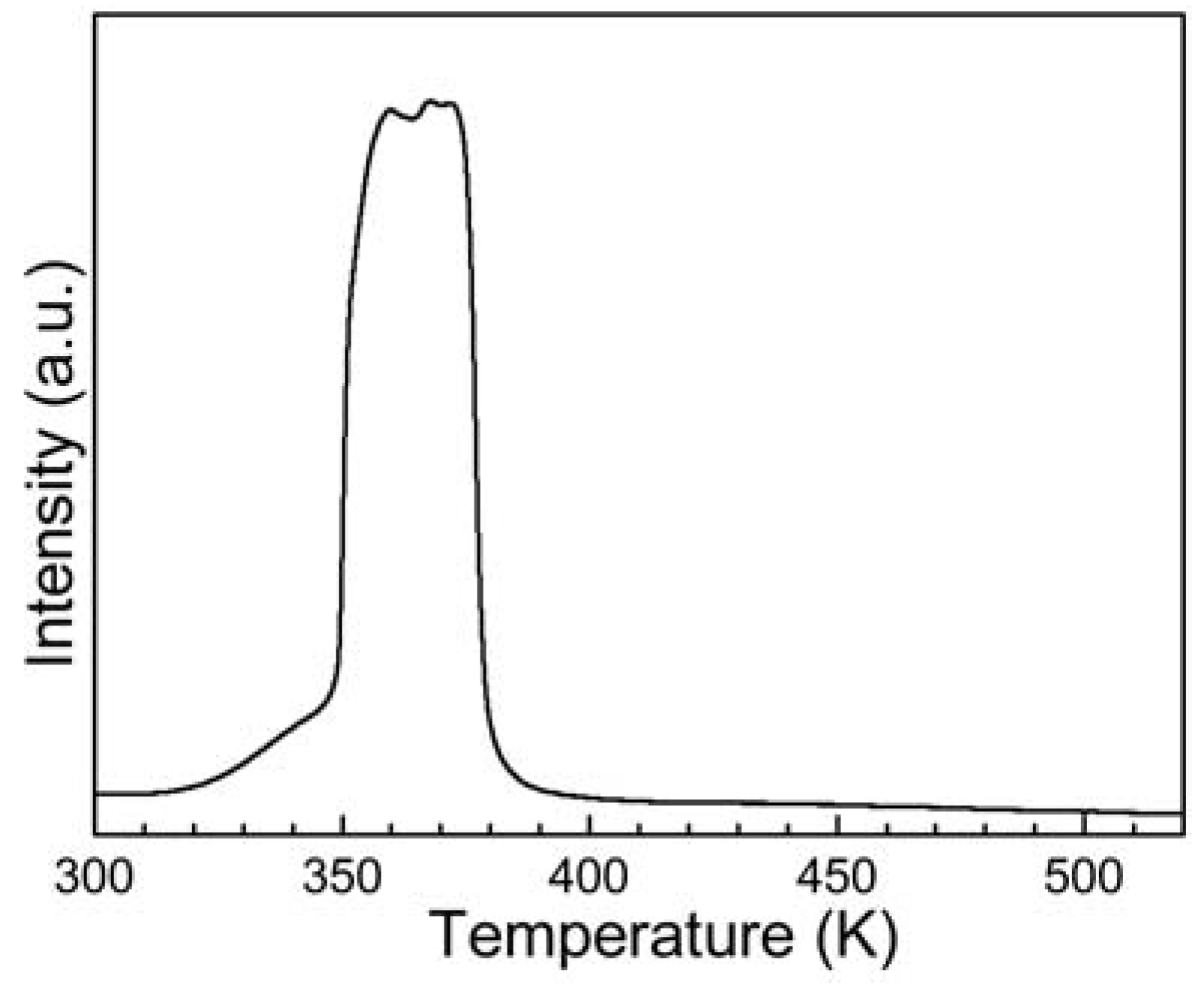



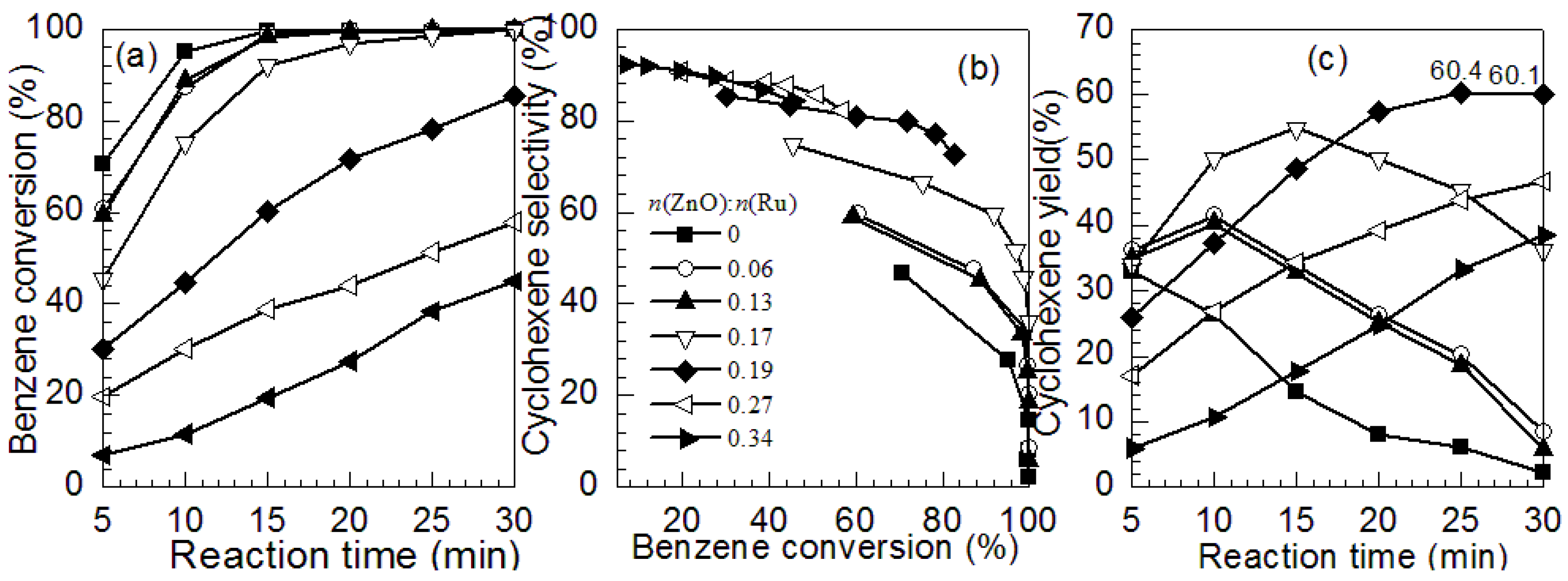

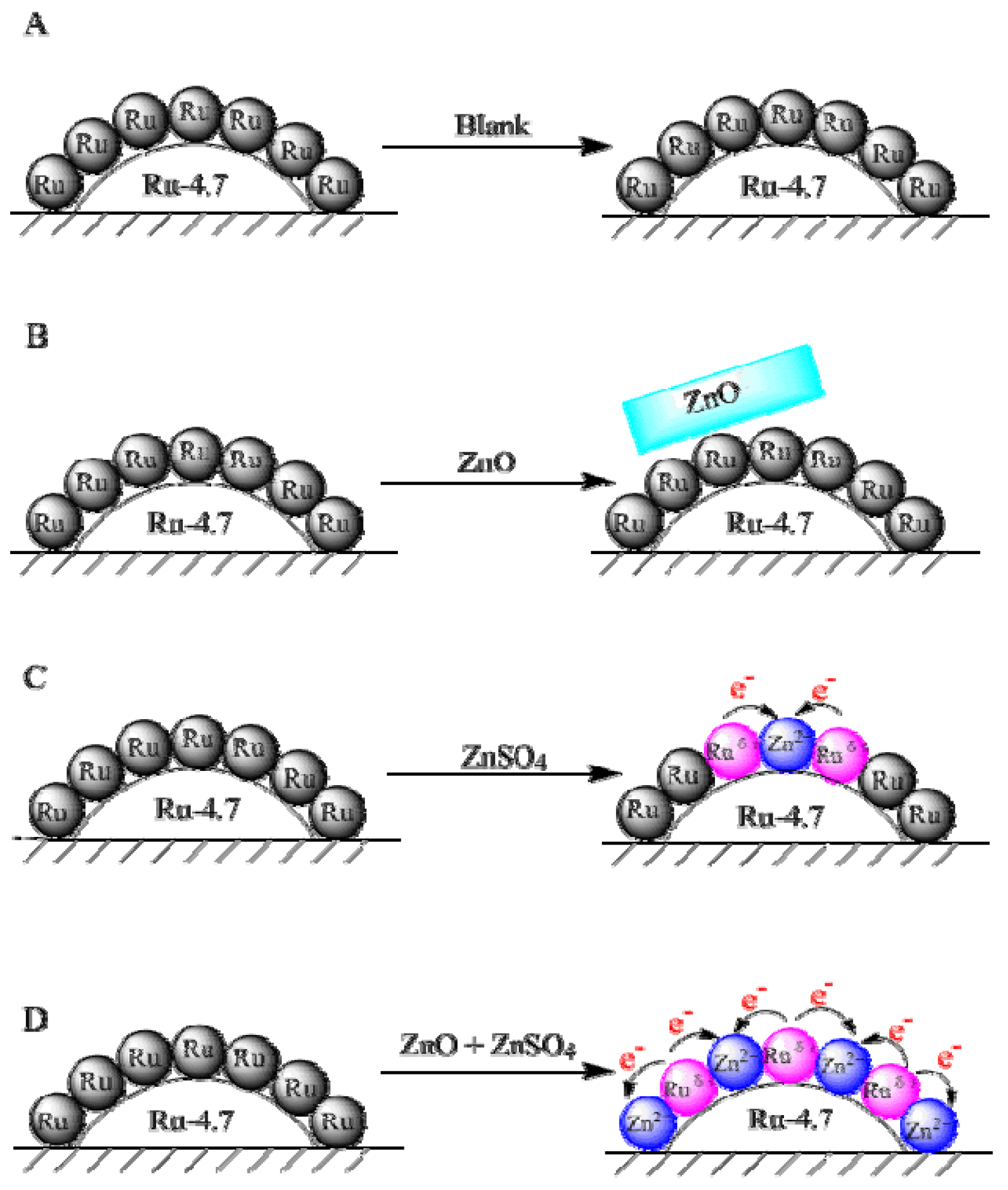
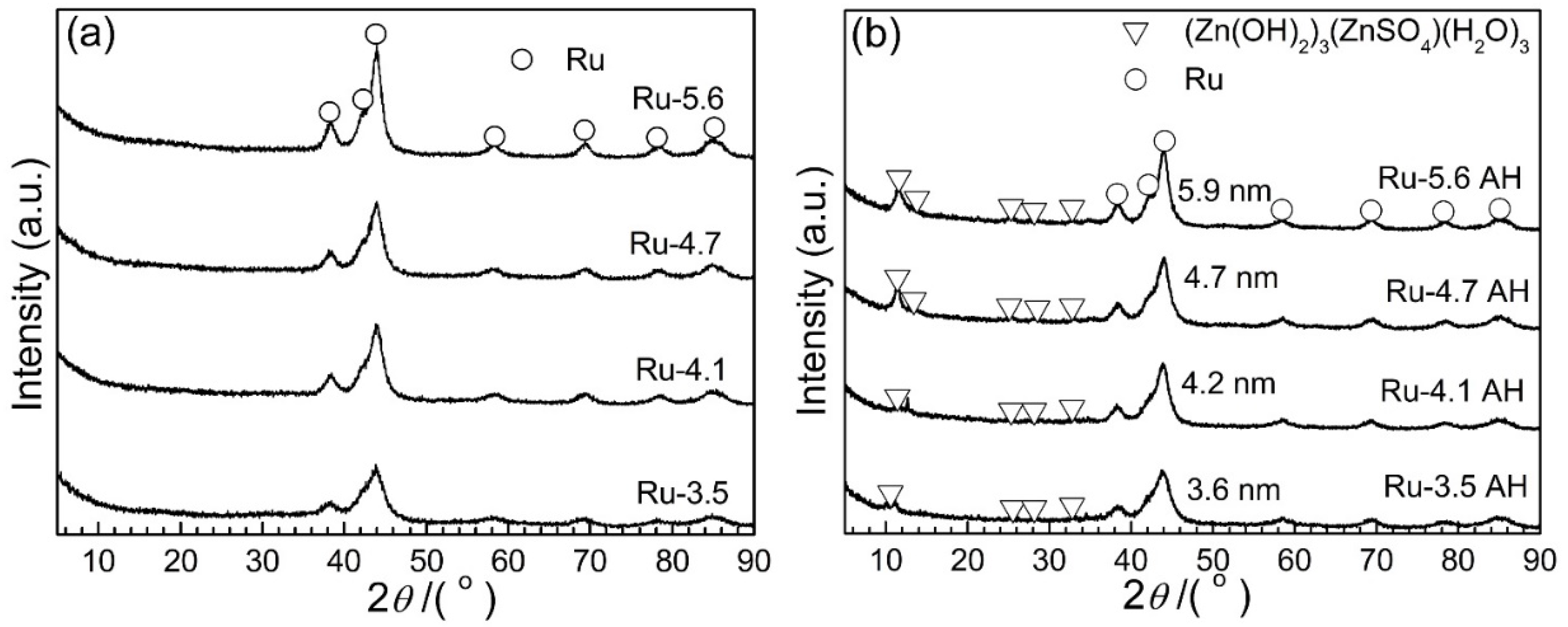


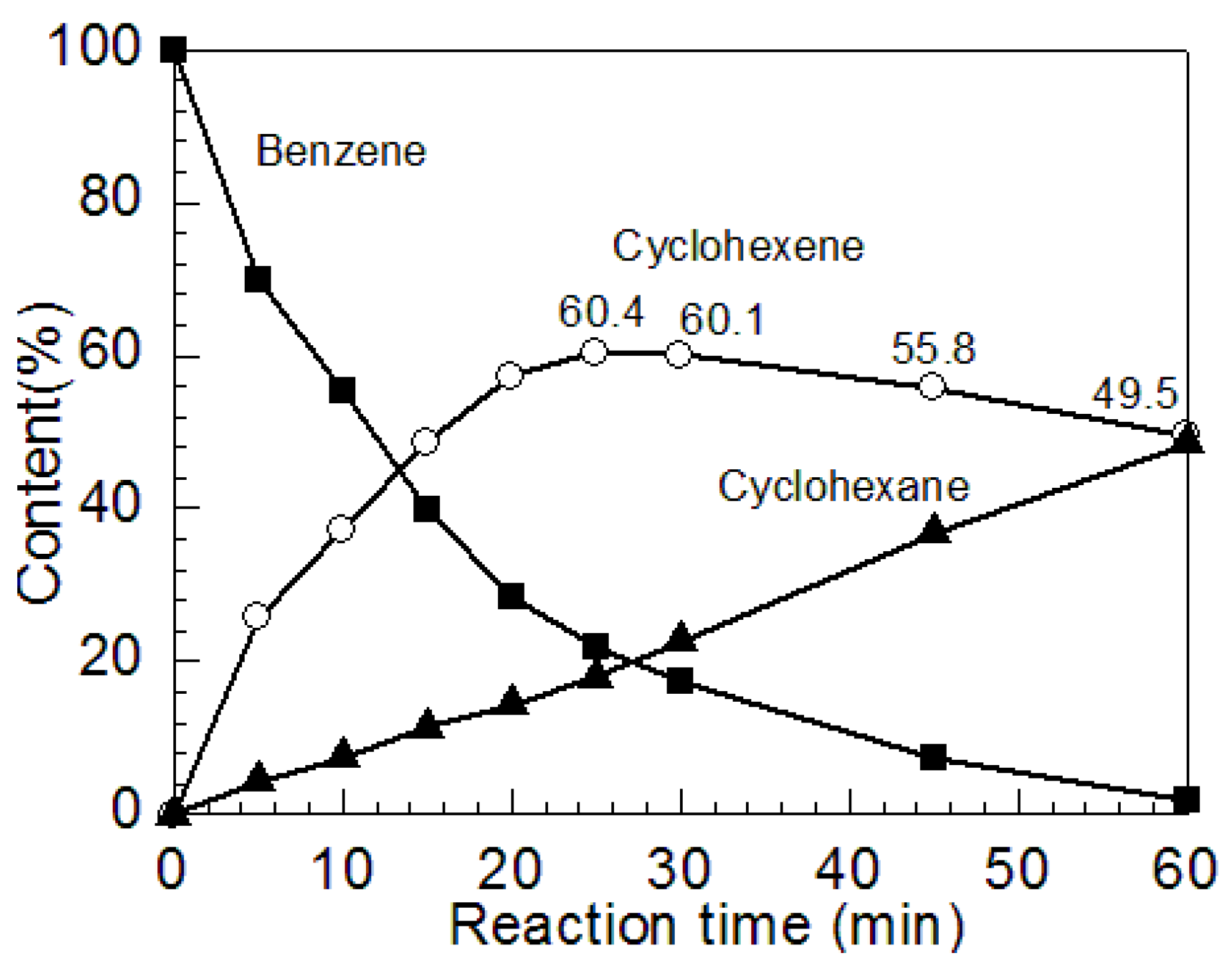


| n(ZnO)/n(Ru) | cZnSO4/mol·L‒1 | n(Zn)/n(Ru)AH 1 | n(S)/n(Ru) AH 1 | Particle Size 2/nm | pH Value 3 |
|---|---|---|---|---|---|
| 0 | 0 | 0 | 0 | 4.6 | 6.97 |
| 0 | 0.62 | 0.0313 | 0.0026 | 4.7 | 5.53 |
| 0.06 | 0.62 | 0.1456 | 0.0067 | 4.7 | 5.78 |
| 0.13 | 0.62 | 0.1711 | 0.0111 | 4.6 | 5.89 |
| 0.17 | 0.62 | 0.1886 | 0.0156 | 4.8 | 5.92 |
| 0.19 | 0.62 | 0.2803 | 0.0336 | 4.7 | 6.01 |
| 0.27 | 0.62 | 0.3194 | 0.0381 | 4.8 | 6.13 |
| 0.34 | 0.62 | 0.4226 | 0.0436 | 4.6 | 6.25 |
| 0.19 | 0 | 0.1792 | 0 | 4.2 | 7.10 |
| Catalyst | SBET/m2 g−1 | Vp/cm3 g−1 | dp/nm |
|---|---|---|---|
| Ru-3.5 | 78 | 0.17 | 5.48 |
| Ru-4.1 | 75 | 0.15 | 7.54 |
| Ru-4.7 | 69 | 0.13 | 8.60 |
| Ru-5.6 | 68 | 0.11 | 9.48 |
| Ru-3.5 AH | 70 | 0.15 | 6.16 |
| Ru-4.1 AH | 68 | 0.13 | 8.26 |
| Ru-4.7 AH | 65 | 0.11 | 8.88 |
| Ru-5.6 AH | 62 | 0.10 | 10.08 |
© 2018 by the authors. Licensee MDPI, Basel, Switzerland. This article is an open access article distributed under the terms and conditions of the Creative Commons Attribution (CC BY) license (http://creativecommons.org/licenses/by/4.0/).
Share and Cite
Sun, H.; Chen, Z.; Li, C.; Chen, L.; Li, Y.; Peng, Z.; Liu, Z.; Liu, S. Selective Hydrogenation of Benzene to Cyclohexene over Monometallic Ru Catalysts: Investigation of ZnO and ZnSO4 as Reaction Additives as Well as Particle Size Effect. Catalysts 2018, 8, 172. https://doi.org/10.3390/catal8050172
Sun H, Chen Z, Li C, Chen L, Li Y, Peng Z, Liu Z, Liu S. Selective Hydrogenation of Benzene to Cyclohexene over Monometallic Ru Catalysts: Investigation of ZnO and ZnSO4 as Reaction Additives as Well as Particle Size Effect. Catalysts. 2018; 8(5):172. https://doi.org/10.3390/catal8050172
Chicago/Turabian StyleSun, Haijie, Zhihao Chen, Chenggang Li, Lingxia Chen, Yan Li, Zhikun Peng, Zhongyi Liu, and Shouchang Liu. 2018. "Selective Hydrogenation of Benzene to Cyclohexene over Monometallic Ru Catalysts: Investigation of ZnO and ZnSO4 as Reaction Additives as Well as Particle Size Effect" Catalysts 8, no. 5: 172. https://doi.org/10.3390/catal8050172






